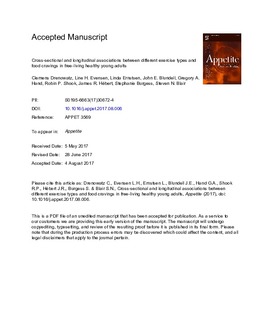| dc.contributor.author | Drenowatz, Clemens | |
| dc.contributor.author | Holtet Evensen, Line | |
| dc.contributor.author | Ernstsen, Linda | |
| dc.contributor.author | Blundell, John E. | |
| dc.contributor.author | Hand, Gregory A. | |
| dc.contributor.author | Shook, Robin P. | |
| dc.contributor.author | Hébert, James R. | |
| dc.contributor.author | Burgess, Stephanie | |
| dc.contributor.author | Blair, Steven N. | |
| dc.date.accessioned | 2018-02-23T12:13:54Z | |
| dc.date.available | 2018-02-23T12:13:54Z | |
| dc.date.created | 2017-08-22T20:16:31Z | |
| dc.date.issued | 2017 | |
| dc.identifier.citation | Appetite. 2017, 118 82-89. | nb_NO |
| dc.identifier.issn | 0195-6663 | |
| dc.identifier.uri | http://hdl.handle.net/11250/2486742 | |
| dc.description.abstract | Introduction
An increase in energy intake due to alterations in hedonic appetite sensations may, at least in part, contribute to lower-than-expected weight loss in exercise interventions. The aim of this study was to examine cross-sectional and longitudinal associations between habitual exercise participation and food cravings in free-living young adults.
Methods
A total of 417 adults (49% male, 28 ± 4 years) reported frequency and duration of walking, aerobic exercise, resistance exercise and other exercise at baseline and every 3 months over a 12-month period. Food cravings were assessed via the Control of Eating Questionnaire at baseline and 12-month follow-up.
Results
Cross-sectional analyses revealed more frequent cravings for chocolate and a greater difficulty to resist food cravings in women compared to men (p < 0.01). Only with resistance exercise significant sex by exercise interaction effects were observed with favorable responses in men but not in women. Significant main effects were shown for walking and aerobic exercise with exercisers reporting more frequent food cravings for chocolate and fruits and greater difficulty to resist eating compared to non-exercisers (p < 0.05). Longitudinal analyses revealed significant interaction effects for other exercise (p < 0.05) with favorable results in men but not women. Furthermore, significant main effects were observed for aerobic exercise, resistance exercise and total exercise with an increase in exercise being associated with a reduced difficulty to resist food cravings (p < 0.05).
Discussion
The association between exercise participation and hedonic appetite sensations varies by exercise type and sex. Even though exercise was associated with more frequent and greater difficulty to food cravings in the cross-sectional analyses, which may be attributed to greater energy demands, longitudinal results indicate beneficial effects of increased exercise on appetite control, particularly in men. | nb_NO |
| dc.language.iso | eng | nb_NO |
| dc.publisher | Elsevier | nb_NO |
| dc.rights | Attribution-NonCommercial-NoDerivatives 4.0 Internasjonal | * |
| dc.rights.uri | http://creativecommons.org/licenses/by-nc-nd/4.0/deed.no | * |
| dc.title | Cross-sectional and longitudinal associations between different exercise types and food cravings in free-living healthy young adults | nb_NO |
| dc.type | Journal article | nb_NO |
| dc.type | Peer reviewed | nb_NO |
| dc.description.version | acceptedVersion | nb_NO |
| dc.source.pagenumber | 82-89 | nb_NO |
| dc.source.volume | 118 | nb_NO |
| dc.source.journal | Appetite | nb_NO |
| dc.identifier.doi | 10.1016/j.appet.2017.08.006 | |
| dc.identifier.cristin | 1488015 | |
| dc.description.localcode | © 2017. This is the authors’ accepted and refereed manuscript to the article. Locked until 7.8.2019 due to copyright restrictions. This manuscript version is made available under the CC-BY-NC-ND 4.0 license http://creativecommons.org/licenses/by-nc-nd/4.0/ | nb_NO |
| cristin.unitcode | 194,65,20,0 | |
| cristin.unitcode | 194,65,25,0 | |
| cristin.unitname | Institutt for samfunnsmedisin og sykepleie | |
| cristin.unitname | Institutt for sirkulasjon og bildediagnostikk | |
| cristin.ispublished | true | |
| cristin.fulltext | postprint | |
| cristin.qualitycode | 1 | |

